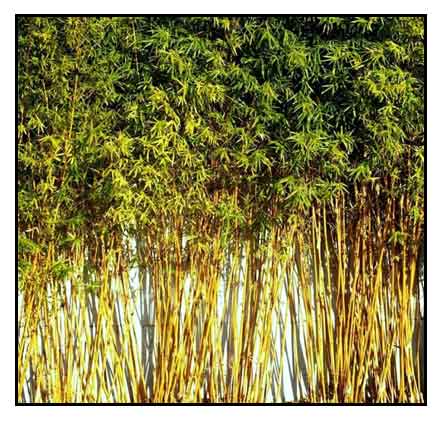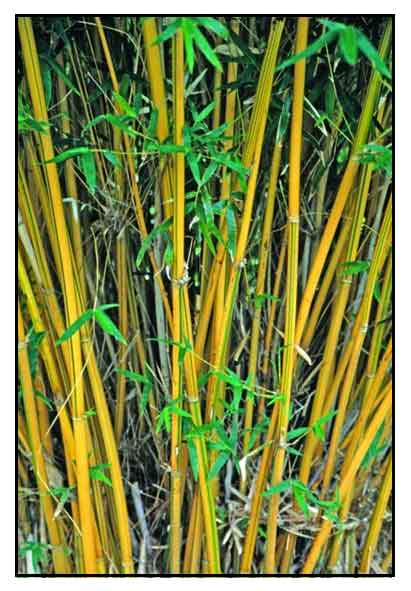 Botany Botany
Bambusa multiplex is an evergreen, densely tufted bamboo, culms erect or arching, 1.5 to 7 m tall, internodes 30 to 60 cm long, covered with white wax when young, smooth, glabrous, nodes not swollen. Culm sheaths are smooth, glabrous, light green when young becoming stramineous, apex rounded, blades narrowly to broadly triangular, tapering to the tip, widened at the base to full width of sheath apex. Leaf blades are 6.5 to 14 by 1 to 1.5 cm, base cuneate or rounded,,sheaths glabrous; auricles small with fine bristles. Inflorescence usually borne on leafless branches. Spikelets are slender, cylindrical when young, 15 to 22 mm long or longer, with 2 glumes ad up to 10 florets; lemma glabrous, keels slightly tinged, lodicules 3. (8)
Distribution
- Introduced.
- Ornamental cultivation.
- Grown as hedge plant and windbreaker.
- Native to China, Nepal, Bhutan, Assam, Sri Lanka, Taiwan and Indonesia.
Constituents
- Study of chemical profile of B. multiple cv. Fernlef leaves yielded twelve compounds. C-glycosyl flavonoids, including vitexin, isovitexin, isoorientin and its derivatives were the main constituents. (9)
- The main functional components of bamboo leave extract are flavone C-glycosides including isoorientin,, isovitexin, orientin and vitexin, which are used as marker compounds for determination of commercial products of bamboo-leaf flavonoids. (see study below) (10)
Properties
Studies have suggested nutritional, repellent, antioxidant properties.
Parts used
Leaves, shoots.
Uses
Edibility
- Shoots are edible, but bitter. Less bitter when harvested before emerging from the soil and parboiled in water. (2)
Folkloric
- In Fiji, shredded leaves are mixed with water and used as wash for treatment of scabies. (3)
- In Malaysia, tea made from shoots and white peppercorns used as abortifacient. (3)
Others
- Fodder: In Nepal, used as fodder.
- Crafts: Canes split easily and are fairly flexible. Used for making utensils and handicrafts. Culms used as umbrella handles or fishing poles (2)
- Paper: Culms used for making paper. (2)
Studies
• Nutritional and Anti-Nutritional Components: Study reports on the optimal time for harvesting the edible shoots. Bamboo shoots were harvested on different days (7 to 30 days after emergence from the ground) and analyzed for chemical, nutritional and anti-nutritional components. There was variation in nutritional composition with overall decrease in protein and increase in dietary fiber and carbohydrate content. All nutritional elements except for calcium decreased with shoot maturity. Optimum harvesting age for shoots was 7 to 10 days, with high nutritional content and almost complete absence of anti-nutritional component cyanide. (5) Nutritional and Anti-Nutritional Components: Study reports on the optimal time for harvesting the edible shoots. Bamboo shoots were harvested on different days (7 to 30 days after emergence from the ground) and analyzed for chemical, nutritional and anti-nutritional components. There was variation in nutritional composition with overall decrease in protein and increase in dietary fiber and carbohydrate content. All nutritional elements except for calcium decreased with shoot maturity. Optimum harvesting age for shoots was 7 to 10 days, with high nutritional content and almost complete absence of anti-nutritional component cyanide. (5)
• Repellent / Fly Larvae: Study evaluated three plant species i.e., Tadehagi triquetrum, Uraria crinita, and Bambusa multiplex for repellence and larvicidal activity of fly larvae infesting fermented fish. The three species were effective in repelling and killing fly larvae. The total effect (repellence and larvicidal effect combined) for each of the three species was significantly more effect for fresh than for dry material. Results suggest potential in augmenting food safety during traditional fermentation in open jars. (6)
• Antioxidant / Essential Oil / Leaves: Study
evaluated the antioxidant capacity of essential oils obtained by steam distillation from four bamboo species viz. Bambusa multiplex, B. vulgaris, Phyllostachys pubescens and Dendrocalamus latiflorus using DPPH assays. Greater antioxidant capacity was shown by B. vulgaris (IC50 2.705 mg/Ml) compared to B. multiple (IC50 3.442 mg/mL. There was not significant differences between the bamboo species. Antioxidant capacity positively correlated with concentration of essential oils.(7)
• Flavone C-Glucosides / Leaves: Study analyzed flavone C-glucosides in the leaves of different species of bamboo (51 species in 17 genera). The main functional components of bamboo leave extract are flavone C-glycosides including isoorientin,, isovitexin, orientin and vitexin, which are used as marker compounds for determination of commercial products of bamboo-leaf flavonoids. Quantitative data showed the content of isoorientin in B. multiplex cv. Silverstripe was higher than two other two test bamboo species and could be a promising plant source for preparation of isoorientin. .(10)
Availability
- Wild-crafted.
- Cultivated. |

![]()





